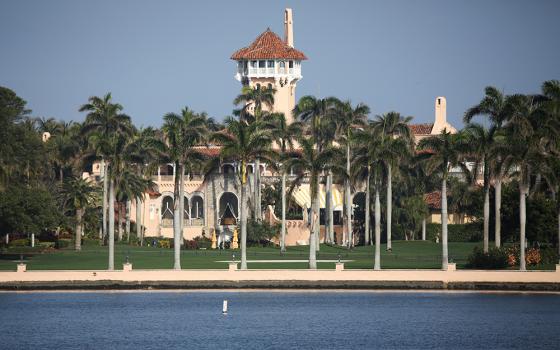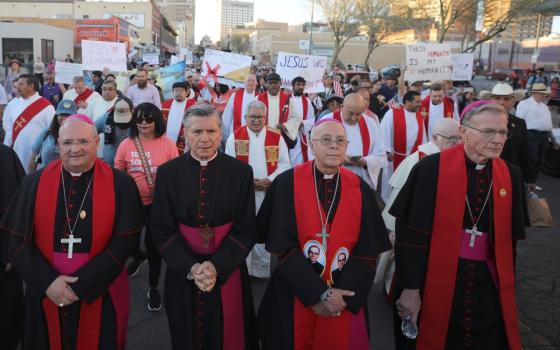
Pope Francis gives his homily during a memorial Mass for cardinals and bishops who died in the past year at the Altar of the Chair in St. Peter's Basilica at the Vatican, Nov. 4, 2024. (CNS/Lola Gomez)
Tomorrow, Pope Francis will create 21 new cardinals, chosen from six continents, and ranging in age from the 44-year-old Ukrainian eparch of Melbourne, Australia, to a 99-year old veteran of the Vatican diplomatic corps.
The timing is dreadful. Everyone, especially clergy, is very busy this time of year. Some of the cardinals, old and new, were just in Rome for the synod. For these reasons, many older cardinals are not making the trip to Rome to welcome their new confreres.
One of the men the pope originally selected, Indonesia's Bishop Paskalis Syukur, asked that he be dispensed from the honor, to which the pope agreed. Francis evidently likes the number 21, and so he added Archbishop Domenico Battaglia of Naples, Italy, to replace Syukur on the roster.
Twenty of the men chosen are under the age of 80 and so will have the right to vote in the next papal conclave, the real one, not the one with Stanley Tucci. Dominican Fr. Timothy Radcliffe, however, will turn 80 next summer, and more cardinals will age out in 2025 as well.
As of this weekend, Francis will have named 80% of the cardinal-electors who will choose his successor. That does not mean that the pope has predetermined the outcome. Lest we forget, all of the cardinals who participated in the 2013 conclave that elected Cardinal Jorge Bergoglio had been appointed by Popes John Paul II and Benedict XVI. Yet, those cardinals moved in a decidedly new direction.
The internationalization of the College of Cardinals is a good thing but it comes with a potential cost. Most of the cardinals will not know each other. The pope has not brought them together in Rome with any frequency for the kinds of meetings that would allow them to become better acquainted. Previously, popes would have the cardinals stay in Rome for meetings for a couple of days. Francis did this for his first consistory in 2014 and for the August 2022 consistory, but not for any of the others.
Consequently, the one group of cardinals most of these cardinals from far-flung countries will know are those in the Roman Curia. Most bishops have regular or at least semi-regular dealings with the Roman Curia, and this new batch of cardinals will likely have had some dealings with the Roman cardinals.
Advertisement
The risk here is akin to that of term limits for members of Congress. In theory, term limits are a great idea, guaranteeing turnover, allowing the will of the people to better make itself felt. In reality, making laws requires expertise, and expertise requires time to acquire. Term limits unintentionally strengthen the hands of full-time lobbyists who possess that expertise. Making laws with term-limited congresspeople and making popes with an internationalized College of Cardinals might both have a reverse effect, strengthening the hand of the insiders.
A conclave in which few cardinals know each other would become dependent on kingmakers, people who know most of the members of the college. Those kingmakers will most likely be drawn from the Roman Curia, as they have been for centuries.
There are exceptions. For example, one of the new cardinals, Archbishop Tarcisio Isao Kikuchi of Tokyo has been president of Caritas International since 2023. In that role, he is traveling the world and will be meeting many other cardinals. This may not make him papabile, but it might make him a kingmaker.
Kikuchi is also a member of a religious order, the Society of the Divine Word. Archbishop Ladislav Nemet of Belgrade, Serbia, belongs to the same religious order. Nine other new cardinals belong to religious orders.
These men introduce a network that crosses geographic boundaries as they are likely to know each other from the governing structures of their orders. Radcliffe, for instance, was formerly the master general of the Dominicans so he knows the other Dominicans in the college.
No new cardinals come from the U.S. but we have enough cardinal-electors — nine — already. One challenge no longer faces them: getting to Rome in time for the vote. Cardinal James Gibbons of Baltimore attended the 1903 conclave, the first non-European to participate. In the conclaves of 1914 and 1922, the American cardinals, who traveled by boat, arrived after the new pope had been elected. After missing the 1922 voting, they won the concession that more time would be allowed between the death of a pope and the start of the conclave.
The one thing Francis can do to ensure a smooth transition is to find an occasion to summon all the cardinals to Rome next year for a multiday gathering. They could discuss synodality, or celebrate the Jubilee together, or mark some other occasion.
When Francis retires or dies, the weight of the Catholic world will fall on the cardinals. The better they know each other, the more likely they will find the right candidate.








